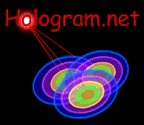![]()
![]()
There are a few basic things to learn about holograms.
First, I will briefly explain the two theories behind the hologram -
1) the wave interference pattern, and 2) the coherency of light.
Then, I will describe how holograms store and project information.
1. Interference Pattern
The hologram is based upon Nobel Prize winner Dennis Gabor's theory concerning interference patterns. Gabor theorized in 1947 that each crest of the wave pattern contains the whole information of its original source, and that this information could be stored on film and reproduced. This is why it is called a hologram.
A pebble, dropped in a still pond, is the most basic example used to describe the wave interference process. If you drop a pebble into a pond, it creates an infinitely expanding circular wave pattern. If you drop two pebbles into a pond the waves' crests would eventually meet. The intersecting points of the waves' crests are called the points of interference. The interference of two or more waves will carry the whole information about all the waves.
![]()
2. Coherent Light
Gabor recorded several images holographically, but wasn't successful at producing a clear image because he could only use forms of incoherent, white light.

An example of incoherent light would be if you were watching cars coming out of a tunnel, you would likely see many different models and types of cars, traveling at different speeds and at different lengths apart. Now, suppose you started seeing the same model and type of cars, all heading down the highway at the same speed, and the same distance apart. This would be an example of coherent light. Holograms need coherent light to record or playback the image clearly.

The L.A.S.E.R. (Light Amplified by Stimulated Emission of Radiation) was invented to produce coherent light. Incoherent light travels in different frequencies and in different phases. Coherent light travels in the same frequency and in the same phase. (100% coherent light is rare) It is important to use light which is coherent because the information is carried on the crest of each wave. The more points of intersection, the more information.
![]()
3. Storing Information
Unlike a camera, which has only one point of light reference, a hologram has two or more points of light references. The intersection points of the two light waves contain the wholeinformation of both reference points. A LASER is used as the light source so the waves are coherent.

A LASER is projected onto a partially silvered mirror called a beam splitter. This mirror splits the original beam into two beams. One beam travels through a lens that diffuses the light onto the object being recorded. This light, called the object beam, is reflected off the object onto the film plate. The second beam is bounced off a mirror and then through a lens that diffuses the light directly onto the film. This beam is called the reference beam. The same light source needs to be used for both beam so the waves will have perfect intersection points.

To add motion (time) to your holograph, you would turn the object, or move the mirrors and lenses, and shoot again onto the same film. The original waves recorded on the film, will intersect with the waves from the new perspective.
![]()
